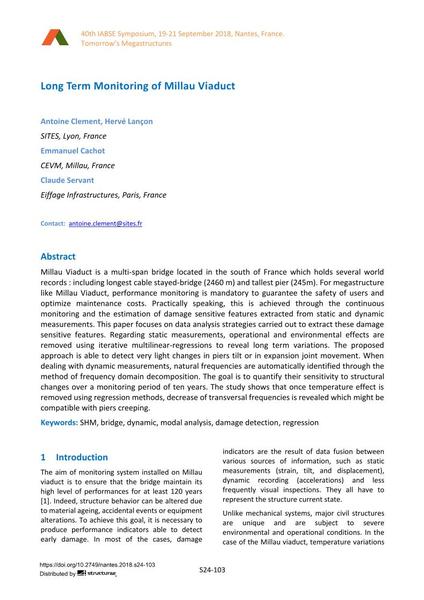Long Term Monitoring of Millau Viaduct

|
|
|||||||||||
Bibliographic Details
| Author(s): |
Antoine Clément
Hervé Lançon (SITES, Lyon, France Emmanuel Cachot CEVM, Millau, France Claude Servant) Emmanuel Cachot Claude Servant |
||||
|---|---|---|---|---|---|
| Medium: | conference paper | ||||
| Language(s): | English | ||||
| Conference: | IABSE Symposium: Tomorrow’s Megastructures, Nantes, France, 19-21 September 2018 | ||||
| Published in: | IABSE Symposium Nantes 2018 | ||||
|
|||||
| Page(s): | S24-103 | ||||
| Total no. of pages: | 8 | ||||
| DOI: | 10.2749/nantes.2018.s24-103 | ||||
| Abstract: |
Millau Viaduct is a multi-span bridge located in the south of France which holds several world records : including longest cable stayed-bridge (2460 m) and tallest pier (245m). For megastructure like Millau Viaduct, performance monitoring is mandatory to guarantee the safety of users and optimize maintenance costs. Practically speaking, this is achieved through the continuous monitoring and the estimation of damage sensitive features extracted from static and dynamic measurements. This paper focuses on data analysis strategies carried out to extract these damage sensitive features. Regarding static measurements, operational and environmental effects are removed using iterative multilinear-regressions to reveal long term variations. The proposed approach is able to detect very light changes in piers tilt or in expansion joint movement. When dealing with dynamic measurements, natural frequencies are automatically identified through the method of frequency domain decomposition. The goal is to quantify their sensitivity to structural changes over a monitoring period of ten years. The study shows that once temperature effect is removed using regression methods, decrease of transversal frequencies is revealed which might be compatible with piers creeping. |
||||
| Keywords: |
bridge modal analysis dynamic damage detection SHM regression
|
||||
